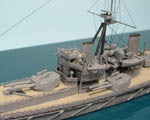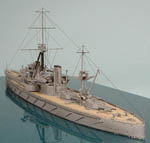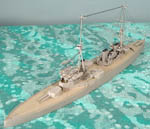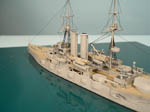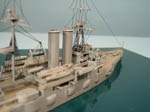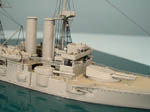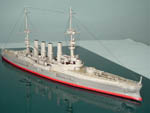|
HMS Dreadnought
1/700 HP Models As built in 1907. This kit required a great deal of attention to reference material as the instructions are rather basic. Fortunately, I have a copy of the Anatomy of the Ship series devoted to Dreadnought, which provided all the information I needed to build the kit with the parts provided and to fill in the details that weren't. For example, the torpedo net had to be fashioned with a length of .030 styrene rod and some ladies hosiery. Torpedo net booms and three sets of coaling gantries had to be added. The masts are scratched from brass rod, and the rigging is .003 fishing tippet line. |
|||
|
HMS Invincible
1/700 Conversion This model of HMS Invincible was built out of the HP Models' HMS Inflexible box. The parts inside cannot be used to build Inflexible and some changes were needed to build Invincible in 1914, just prior to the Battle of the Falklands. I had to reshape the 'midship turrets as they were made by a different manufacturer and were powered differently on the prototype. The small guns atop the 'midhips turrets came from a Seals Models accessory pack for Early RN and IJN ships. Some of the ships' boats came from the pack as well. The colo(u)r was chosen after research indicated that in 1914, RN ships used a Medium Gray paint made of 20 parts white and one part black. I brewed up a sample using Ceramcoat paints, took a "colo(u)r chip" to the hobby shop, and selected Tamiya Medium Gray. The model was photographed on a naval wargame mat -- hence the camouflaged hexes. |
||
|
IJN Mikasa
Seals Models 1/700 This was a beautiful kit to work with. I used decals for the white stripes on the funnels and .003 fishing tippet line for the rigging. Other than that it was built out-of-the-box. |
|
|
IJN Lexington
Fujimi 1/700 The Fujimi Lexington in pre-war mode with Gunze-Sanyo Mahogany on the flight deck and WEM F3Fs and SB2Us ready for a practice strike. I converted all the 20mms to .50 calibers. |
|
|
USS Saratoga
Fujimi 1/700 This is painted in PollyScale Navy Blue (5-N). No, I didn't accurize the funnel. But I did sand away all the raised lines on the flight deck. It also needs a gangway between the bridge and the funnel. I'm hoping some PE manufacturer will make one. Then, I'll flod it, paint it and glue it on. |
|
|
USS Maryland
Hi Mold 1/700 She's painted in measure 1 with Gunze Sanyo Extra Dark Sea Gray, PollyScale Light Gray (5-L) and paint from an ancient tin of Humbrol "Natural Teak.". The cagemasts weren't nearly as difficult as I thought they'd be. I just used a 1/8 inch diameter metal rod and rolled the PE in the palm of my hand until the correct shape was formed. I hid the seam with a ladder glued to the outside of the cage. To make the model more accurate for Pearl Harbor, I had to add some strip styrene for the torpedo bulges. I can highly recommend this model. |
|||
|
USS Pennsylvania
Revell 1/720 conversion I converted the Revell USS Arizona into her sister ship, the USS Pennsylvania after reading an article listmember Jim Kloek wrote for Finescale Modeler's 1995 "Modeling the Second World War." The article was very easy to follow. All you need is some PE, some parts from the Skywave E-6 Equipment set and some strip styrene. |
|
|
King Edward VII This ship was the last in a line of designs from William White -- my favorite naval architect -- and was the last battleship completed before the HMS Dreadnought was launched. This kit is fantastic and went together easily, for a resin kit. The first difficult bit was removing and sanding the parts on the resin wafers. Some of the larger pieces on the wafers were warped, but a gentle dousing in very warm water took the warp out. The only other challenges were in constructing the masts out of brass rod and stringing the rigging (with .003 fishing tippet line). I chose to depict her in her World War I fit. She's painted in the "light gray" scheme, which was described as 20 parts white and one part black. The deck is painted using the long out-of-production Humbrol Deck Plank. |
||
|
This is the 1/700 scale HP Models SMS
Deutchland built as she appeared in 1914 prior to hostilities breaking
out in Europe. This is a relatively simple kit to assemble. What made
it more difficult was the search for photo references. I replaced the
tertiary guns with parts from the Seals Model pre-dreadnought accessories
kit. The masts were scratched from brass rod. I used Toms Modelworks
rails and ladders. The rigging was done with .003 fishing tippet line
darkened with a black Magic Marker.
The ship is painted with Ceramcoat's Drizzle Gray, Rain Gray and Payne's Gray (standing in for black), Pollyscale's Deck Tan and ModelMaster's Engine Gray for the "jet black" turret tops. The yellow funnel bands are decals. The linoleum decks are painted with a mix of Ceramcoat's Brown Iron Oxide and Autumn Brown. The Deutschland class was the last class of pre-dreadnoughts built by the German Navy. The class steamed with the High Seas Fleet at the Battle of Jutland, bringing up the rear in the approach to the engagement. A sister ship, the Pommern, blew up during the battle. Another sister, Schleswig-Holstein, fired the opening salvos of World War part 2. |
||
|
This is the 1/700 scale SMS Gneisenau.
The kit is from HP Models an amazingly prolific company located in Germany.
I bought mine from Pacific Front Hobbies. The parts come off a rather
thick wafer, requiring a good amount of sanding to get them right. The
most difficult part was building the masts using brass rod. I added
the photo-etched railings and replaced the warped resin 8" barrels with
the appropriate sized steel tubing.
The model is painted using Ceramcoat grays and an ancient tin of Humbrol Deck Plank. The waterline is a decal. It's rigged with .oo3 fishing tippet line darkened with a felt-tiped marker. |
||
Copyright © SMML 2004
